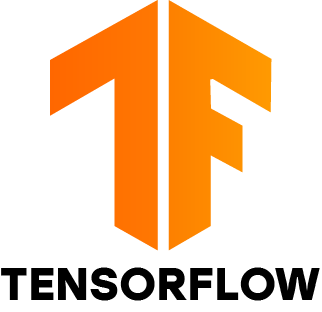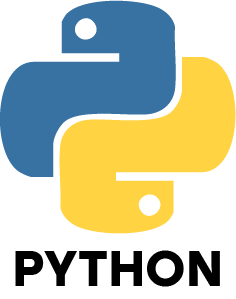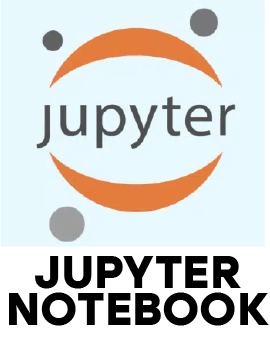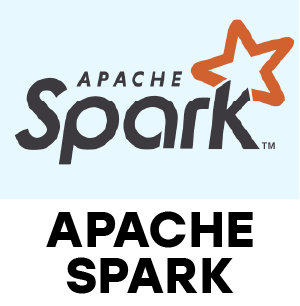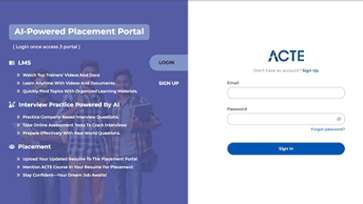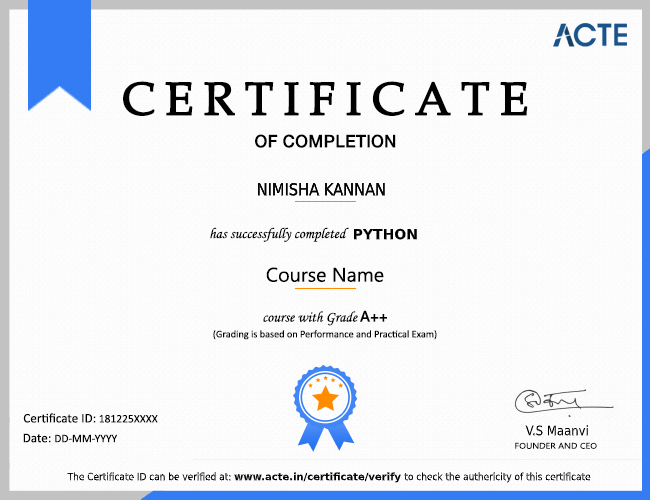The python training course offered by ACTE provides you with an understanding and in-depth expertise in the construction of python codes and packages such as SciPy, Matplotlib, Pandas (scientific teaching), Scikit-Larn, NumPy, internet scraping libraries, and the Lambda function.
Throughout the course content, business experts seek to establish the most efficient employment in highly qualified MNCs.
As part of this training, you may be asked to engage in real-time initiatives and activities that have a significant influence on the real world of business, making it easier for you to advance in your career.
Additional Info
Introduction of Data Science with Python:
The Python Data Science course allows you to study these principles from the beginning. It provides you with mastering key concepts for Python programming, such as data processing, file operations, but also object-oriented programming. This Python Data Science course also will help you understand the various types of machine learning, advice systems, and many more information science subjects to start your data science profession.
Python Data Science is a course that will teach you the foundations of Python programming. As part of this Data Science with Python certification program, you will learn Data Analysis, Machine Learning, Data Visualization, Web Scraping, and Natural Language Processing (NLP). You will have mastered the core tools of Data Science with Python after finishing this course.
Who can Learn Data Science with Python:
- Python is a simple computer language that has long been acknowledged from a syntactic standpoint.
- Python also has a huge number of libraries and resources, as well as a vibrant community.
- You have a platform that you can use with emerging technologies like machine learning and data science.
- Data science experts do not want to be bogged down by complicated programming requirements.
- They would want to use programming languages such as Python and Ruby without difficulty.
- Ruby excels in a variety of data pre-processing tasks, such as data clearing and data munging.
- However, there aren't as many machine learning libraries as there are for Python.
Therefore, Python is at the forefront in terms of data science and machine learning. Moreover, Python enables developers to create programs to speed up the development process and to do prototypes. When transforming the project into an analytical tool or application, it may be translated into more complex languages like Java or C if necessary.
Python is attracting new data scientists because of its user-friendly approach. Python is so popular that a staggering 48 percent of data scientists with five or fewer years of experience consider it their preferred programming language. The increase in the level of expertise and analysis reduces this number. Python proved to be an excellent starting point for data scientists.
Why is Python preferable to knowledge?
- Python is the language of choice for daily work by data scientists and a major tool in the field of data science.
- For data scientists needing to add statistical code into production databases or to link data to web-based applications, Python is often the ideal solution.
- It may also be used for algorithms that are normally performed by data scientists.
- Other Python packages, such as pandas, NumPy, and SciPy, are intended specifically for certain purposes.
- Python's sci-kit-learn package is a valuable resource for data scientists working on machine learning applications.
- Matplotlib is another great Python package for data science applications that require graphics and other visualizations.
- Pythonic code is defined as code that is written in a fluid and natural way.
- Aside from that, Python is well-known for other features that have attracted the data science community's interest.
Why is Python important in data analysis?
It's supple.Python is the ideal choice for you if you want to achieve something unique that has never been done before.
It is excellent for creating scriptable apps and web pages.It's Easy to Understand.Because of its emphasis on simplicity and readability, it has a reasonably smooth and low learning curve.A python is an excellent tool for beginning programmers owing to its simplicity. Python provides programmers with the advantage of requiring fewer lines of code to complete tasks than earlier languages. To put it another way, you spend less time dealing with code and more time playing with it.
Source Open It's there. Python is open-source that means it is free and uses a community development model. Python is suitable for applications on Windows and Linux. It may also be moved easily to several platforms. There are several open-source libraries in Python, such as data handling, data visualization, statistics, arithmetic, machine learning, and natural language processing (though see below for more about this).
It has a lot of backing. Anything that can go wrong will go wrong, and if you're using something for which you didn't have to pay, getting assistance may be tough. Python, thankfully, has a large following and is extensively used in academic and industrial circles, thus many useful analytics packages are available. Python users who need help may always turn to Stack Overflow, mailing lists, and user-contributed code and documentation. As Python's popularity rises, more users will provide information about their user experiences, resulting in more free assistance material.
Certification Of Data Science with Python:
1. After completing the data science effectively using python courses, Simplilearn provides you a certificate of industry-recognized completion with everlasting validity.
2. Thanks to our well-established field knowledge and well-known customers both in India and globally, theAnalytixLabs certification is well regarded in the industry.
3. As the Indian Data Science Institute of top-class, we must preserve the dignity of our certification system.
4. You will only be awarded a certificate after presenting and fairly assessing a required project work as part of your training course.
5. There is no pass/fail for these activities and projects.
6. If the assignments and projects are out of date, trainees should be engaged to help with improvisation and support. However, no plagiarism is tolerated throughout the examination.
7. There is no pass/fail for these activities and projects, except MCQ tests.
8. You will have two opportunities to pass the MCQ examinations if you participate in the dual certification program.
9.Our objective is to provide trainees excellent hands-on experience so that they are well-prepared for job interviews and perform well at their jobs.
Career Growth Of Data Science with Python:
- Our courses are intended to avoid preconditions and require no prior expertise.
- Data scientists must have mastery of required technical skills such as Python and objectives and functions.
- Along the way, you will also learn about important libraries like scientists learning, Matplotlib, NumPy, and pandas.
- In addition, in our Python data science course, you'll learn all you need to know about web scraping and SQL queries.
- The majority of the programs for data science finish there because they are the only skills needed to become a data scientist.
- We included ideas such as UNIX, Git, and Github to promote teamwork and effectiveness to help you stand out from the crowd.
- At Dataquest we realize how hard it is to follow a whole new professional route, thus we are learning exclusively.
- Our lessons are always practical and attractive.
- Say farewell to the lengthy videos, dull.
- You will frequently create and execute actual code using Dataquest to check your new capabilities.
- We're going to assist you to get on the road again if you get stranded.
- The curriculum of the data scientist is structured.
- Our Python data science career offers a variety of courses ranging from an introduction to Python for beginners to advanced Python for data science.
- In practice, you will create actual code and respond to problems, allowing you to understand certain data science abilities.
- You will complete a guided project after each session to demonstrate your new skills to potential employers while building your portfolio.
- You will receive a certificate at the end of each session that you can share or use to improve your résumé with your professional network.
- After completing the full program, you have all the competencies necessary to become a data scientist.
Industry Trends in Data Science with Python:
TensorFlow - TensorFlow is a library for advanced numerical calculations that has approximately 35000 comments and a dynamic community of about 500 developers. It is used in a variety of scientific fields. TensorFlow is a framework for the definition and execution of tensor computations that measure machine objects that are partially specified and then offer a value. Improved machine graph visualization. Errors in neural machine learning are reduced by 50 to 60%. Parallel computing to run complicated models, with smooth library management.
SciPy is another free, ASCII text file library Python for knowledge study, commonly used for high-level computations, which can be found in Python's scientific python. Zippy has about nineteen GitHub projects and a prosperous population of some 600 inhabitants. They are extensively used in scientific and technical computations because they expand NumPy and give several easy and cost-effective scientific calculation techniques. Python uses the NumPy module to write algorithms and features.
NumPy — As the core computer module in Python, NumPy (numerical python) provides a powerful N-dimensional array object.On GitHub, there are about 18000 comments and a thriving 700-person community.It is a general-purpose array processing software that uses superior flat objects known as arrays and tools.Furthermore, NumPy mitigates the slow disadvantage by providing flat arrays for the efficient supply of features and operators.
Matplotlib - Matplotlib creates powerful yet visually appealing visualizations.It's a Python charting library with over 26,000 comments on GitHub and a strong developer community of 700.Because of the graphs and charts that it creates, it is frequently used for information mental.If you want to incorporate similar graphs in your apps, it also provides an object-oriented API.
PyTorch — PyTorch is the next item on the list of the top Python libraries for data science. It is a Python-based scientific computing tool that makes use of the power of graphics processing units. PyTorch is a popular deep learning system for research that is meant to provide maximum flexibility and speed.
BeautifulSoup is a popular Python data science tool. This is another well-known Python package for internet creep and information scraping. Users will acquire information from a website's square measure without a suitable CSV or API, and BeautifulSoup will aid them in scraping it and formatting it in the required manner.
Roles and Responsibilities Data Science with Python:
- Management: The data scientist has a little management role in assisting with the creation of a database of futuristic and technological abilities to support different planned and ongoing data analyses.
- Analytics: The data scientist has a scientific role in the design, implementation, and evaluation of high-level statistics and strategies for use in the most complex business issues. The data scientist develops economic and statistical models for a variety of topics such as projections, classification, clustering, pattern analysis, sampling, simulation, and so on.
- Strategy: In developing innovative strategies to analyze customer patterns and business management of the company, the data scientist is essential as it addresses the complicated business challenges, such as product fulfillment optimization and overall profitability.
- Collaboration: The role of the Data Scientist is not alone, and it collaborates with senior data scientists to provide key stakeholders with problems and outcomes to enhance corporate performance and decision making.
- Knowledge: The Data Scientist is also in charge of researching new technologies and methodologies to bring fresh data-driven insights to the organization as quickly as feasible. In this scenario, the data scientist takes the initiative to study and implement new and improved business data science techniques that he presents to the SCO.
- Additional Duties and Tasks: A data scientist may be assigned additional responsibilities and tasks by the senior data scientist, the data science director, the data manager, or the company.
Advantages Data Science with Python:
1. Simplicity:
- The first thing to remember about Python's attraction for programming and data science is its simplicity.
- One of its greatest features is the inherent easiness and accessibility of Python as a beginner-friendly language.
- Its obvious syntax enables a shorter curve of learning than most other languages.
- In Python, you may construct a program considerably quicker than in other languages such as C++ or Java.
- By allowing you to jump straight into the study without having to read documents for hours, Python spares time.
- Now, Python is extensively used to analyze data, analyze statistics, create a web, process text, and a range of other activities.
2. Bibliothèques - there's one for every need:
- While Python's simplicity makes it the first choice for many, its fantastic library collection makes it even more appealing to data scientists.
- Python has been improved throughout time by the addition of libraries that extend its capabilities.
- You are certain that you will find a plethora of libraries that are specifically designed to satisfy your data science needs.
- NumPy was one of the first libraries in the field of data science.
- It is suitable for scientific computation because it contains high-level arithmetic operations that operate on multi-dimensional arrays and matrices.
- SciPy is NumPy's scientific equivalent.
- It contains all of the instruments required for efficient numerical integration and scientific data processing.
- Matplotlib is a two-dimensional charting program that provides all of the tools needed for data visualization.
- Scikit-Learn and PyBrain are machine learning packages that provide building blocks for neural networks.
- Other libraries include to name a few, SymPy (statistical applications); Shogun, PyLearn2, and PyMC (machine learning); Bokeh, ggplot, Plotly, prettyplotlib, and seaborn (data visualization and charting); and csvkit, PyTables, and SQLite3 (data processing and storage).
3. A multi-paradigm approach:
- A positive aspect about Python is that, in contrast to OOP languages, it is a multi-paradigm programming language.
- To print "Hello World," for example, in Java, it is necessary to construct a distinct OO class, but in Python, you don't do it.
- Python offers multi-paradigmatic methods for functional, procedural, and object-specific programming and aspect-driven approaches.
4. Enterprise application integration (EAI):
- Python is an excellent platform for integrating corporate applications (EAI).
- As previously said, Python is deeply embedded in programs written in various programming languages.
- This makes it easy to combine web development with other languages.
- You may, for example, call CORBA/COM components as well as Java, C++, and C code directly and directly.
- Python's strong compatibility with Java, C, and C++ makes it a suitable application scripting option.
- A python, due to its excellent text processing and integration skills, is also a useful software test tool.
- It has its testing frame and may also be used to develop sophisticated GUI desktop applications.
5.The sixth item on the list is the Jupyter Notebook:
- The Jupyter Notebook is well-known among Python programmers.
- It's a free and open-source online tool for programmers to develop expressive code.
- The Jupyter Notebook is a valuable data science and machine learning tool.
- It enables you to show your findings and include the results (visualizations) into the same document as your code.
- The Jupyter Notebook is one of Google Colaboratory's various services, which allow you to run the Jupyter Notebook using free cloud resources and highly performing GPUs.
- As Google Colab is synchronized with applications on Google Drive, you may store your data and notes on your Google Drive.
6. There is always someone in the community on whom you may rely:
- For better or worse, the Python community will always be there for you.
- There is no issue, problem, or question that Python enthusiasts and volunteers will not solve or answer.
- All you have to do is ask.
- One of the most wonderful aspects of open-source communities is that they are always open to debate.
- In short, in the field of data science, Python has proved to be a game-changer.
- This is the first choice of many data scientists and data analysts all around the world and is so full of important features and tools.
- We are certain that the aforementioned reasons are enough to illustrate Python's advantages for data science.
project of Data Science with Python:
1. Python is one of the most creative information science programming frameworks on the planet.
2. It is also one of the simplest programming languages once it has the capability.
3. However, there is still a large gap between supply and demand for python expertise.
4. The ability gap does not present in Bharat alone, but rather around the world.
5. Even the most significant coding firms in India lack the necessary Python resources.
6. While language quality has improved, the willingness to pursue a course or certification is still insufficient. This capacity to begin a career is insufficient.
7. Developer Python: This is one of the easiest professions to gain if you utilize this talent.
8. The data in the above section clearly illustrate that Python developer positions are always open to fill.
9. Creating reusable and cost-effective websites for IT issues, analytics, and building technologies.
10. Optimize data protection and security information algorithms.
Tools for Data Science with Python:
- Minitab.
- Kafka's (Apache).
- QlikView.
- MicroStrategy.
- Google Analytics is a web analytics service provided by Google.
- Julia.
- SPSS.
- MATLAB.
Benefits of Data Science with Python:
- Python is a smart technology with several advantages in the field of data research.
- Because it is open-source, it is adaptable and constantly evolving.
- Furthermore, Python provides several useful libraries that may be used in conjunction with existing structures from other languages (such as Java).
- Short story - Python is an excellent data science tool.
- Python's first of numerous advantages is the simplicity of the knowledge.
- While some scientists have technical backgrounds and/or recognize different programming languages, they have various statistical backgrounds, arithmetics, or other approaches, and should not have the greatest amount of cryptographic competence after joining the field of knowledge.
- The syntax of Python is straightforward to understand and write, making it quick to start and learn.
- If the sheer number of individuals who use Python isn't enough to persuade you of its importance in knowledge science, maybe the libraries available to simplify knowledge science cryptography will.
- A library in Python might be a collection of modules with pre-built code to assist with common tasks.
- They effectively allow the US to profit from and rely on the work of others.
- Some knowledge science tasks would be difficult and time-consuming to code in other languages from start.
- NumPy, Pandas, and Matplotlib are some Python libraries that may be used to create knowledge cleansing, knowledge analysis, knowledge visual pictures, and machine learning.
Skills of Data Science with Python:
- Coding skills, statistical comprehension, and the ability to think critically are all required of a successful data scientist
- Some of the data scientist skills necessary in data science that will profit from plentiful employment opportunities are
- R/Python/Java program language for applied mathematics and statistics
- Hadoop's job experience
- SQL and NoSQL databases using machine learning and neural networks
- Expertise within the context of profound learning
- TensorFlow, Pytorch, and Keras
- Understanding of creative ideas and industry
- Data visualization
- Data mining and analysis
- Data Mixing and Manipulation
- Statistics analysis and modeling
- Predictive modeling
- Python Data Analysis
Pay Scale Data Science with Python:
- The most important and sought competence is R knowledge followed by Python.
- Python's wage pledges INR 10.2 lakhs in India alone.
- The combination of big data and data science boosts a data analyst's income by 26 percent compared to simply one area of expertise.
- SAS users are paid between INR 9.1 and 10.8 lakhs compared with SPSS professionals for INR 7.3 lakhs.
- Machine earnings in India are starting to reach 16 lakhs if you develop in this field in the region of 3.5 lakhs INR.
- Python is one of the best languages in ML, with the Python developer wages being one of the highest in India.
- Python's wage pledges INR 10.2 lakhs in India alone.
- In comparison to competence in only one subject, combining an understanding of big data and data science increases a data analyst's pay by 26%.
- SAS users are rewarded between INR 9.1-10.8 lakhs, whilst SPSS professionals are awarded between INR 7.3 lakhs.
- A thorough grasp of Artificial Intelligence can help you grow in your career.
- If you are new to the industry, the average Artificial Intelligence salary in India is between 5 and 6 lakh INR.


